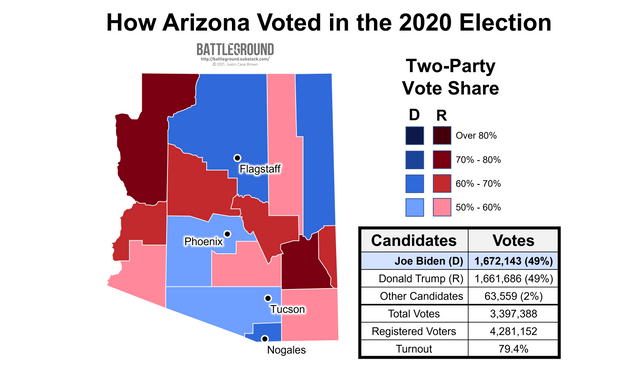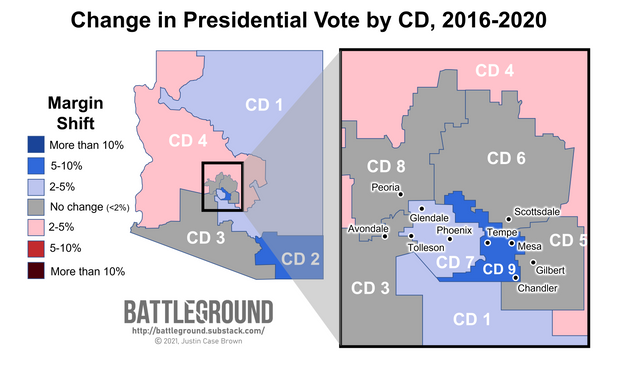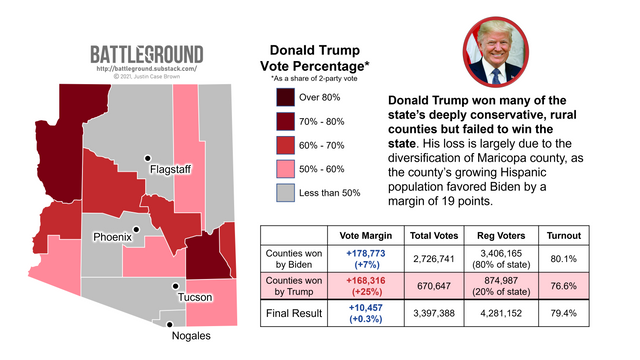The News Has Focused on Arizona's Audit, Do You Know How Voters Even Voted?

It always comes down to Maricopa County. The county is Arizona’s most populous, holding slightly over 60% of its voters as well as the state capital: Phoenix. The county routinely has close margins in presidential elections but almost always votes Republican. Joe Biden’s win here marks the first time a Democratic candidate has won it since Harry Truman in 1948. The first sign of political change lies within the state’s demographics: Phoenix is one of the fastest growing cities in the US and its largely due to its burgeoning Hispanic population. Biden won this important group of county voters by a margin of 19 points. Biden was able to secure a win here also due to shifts in the county’s suburban areas that typically hold a larger base of white, moderately conservative voters. It’s difficult to see exactly where these changes are happening on the ground when sticking to county-level results. Looking at the presidential vote broken down by the state’s congressional districts does a better job of showing see exactly where these shifts are occurring.

The towns that saw the largest shift between the two presidential elections, (Tempe, Mesa and Chandler) fell within the state’s suburban 9th congressional district. Kyrsten Sinema represented this district for six years before becoming a US Senator and the voters have posted consistently wider margins for Democrats since it was first established as Arizona’s newest congressional district in 2012. For the past decade the district remained a surprisingly moderate district; a place where the most recent Republican House candidate embraced the science of climate change and the current Democratic representative touted his ability to work with (rather than against) Republicans as mayor of Phoenix. Pres. Joe Biden also managed to flip the state’s snaky 1st district which strains to link up much of the state’s northern rural areas (much of which is comprised of Native American reservations) with Phoenix’s southern exurbs. These areas’ minor Democratic tilts helped break Arizona’s long history of supporting Republican presidential candidates.

Donald Trump’s strongest base of support lied outside of Maricopa county in the state’s more rural counties. Mohave County in the northwest corner of the state is reliably one of the reddest counties in Arizona. Much like states in the Deep South, voters here often stick to the conservative “Three G’s” when engaging with politics: God, guns and gays. Despite lying outside of the traditional reaches of the Bible Belt, voters in Arizona’s rural areas are often religious and stick closely to traditional conservative values.
While Trump failed to gain support where he needed to within Maricopa county, he made surprising inroads in Santa Cruz county along the US-Mexico border. He gained an extra 7 percent of the vote compared to his performance in 2016, eating away at what is traditionally a wide margin for Democrats. This trend resembles shifts seen in Texas and Florida as more than 80% of the county’s voters identify as Hispanic or Latino, proving that the Republican party is gaining momentum within a multitude of Latino communities nationwide. Anecdotes paint a surprisingly familiar picture resembling that of conservative white voters in the Deep South: as the Democratic party continues to lean left, an increasing amount of Hispanic voters with ancestral ties to Democrats are questioning how their current values match today’s party.
Santa Cruz County Supervisor Manny Ruiz explains that Santa Cruz county’s connection to the Democratic party is “very generational… I think that once you’re a Democrat, you’re always a Democrat.” Looking at older data shows this holds true; the county has been one of the bluest in Arizona for decades as Republicans have consistently lost local campaigns in the county. However, the recent vote shift toward Republicans proves that an increasing amount of voters are experiencing a political re-awakening. Sergio Valdez, a former molecular biologist, questioned his own political ideology when returning home to the county seat Nogales after attending the University of Arizona…
I’ve been seeing a lot of politicians who are very unqualified at what they’re doing and nobody is holding them accountable… I feel like the only way I can change things is if I get involved in politics… Patriotism is about staying here and fighting the problem.
Forecasting the Future: Donald Trump’s narrow loss in Arizona doesn’t necessarily portend a new era of Democratic dominance in the state. While he failed to galvanize Hispanic voters within the populous center of the state, Republicans are making inroads among this increasingly important voting bloc elsewhere. Meanwhile, the national Democratic party’s leftward lean falls at odds with the more moderate voting base in Arizona. This continued divergence could blunt recent changes seen in and around Phoenix. The surprising bright spot for Democrats that has gone under-reported was the major rise in turnout of Native Americans on reservations in the northeastern reaches of the state. Apache county is mostly comprised of the Navajo Nation; roughly 70% of the county’s residents identify as Native American. The county regularly votes for Democrats and between 2016 and 2020 saw a 30% increase in its total voting base, growing from 27,000 to 35,000 ballots cast in the presidential election. Voters here favored Biden by a margin of 2-to-1 over Trump, most definitely contributing to Joe Biden’s nail-biter of a win.
(This piece is a taste of the work I do on the daily for my map-based political newsletter Battleground. I focus on individual states and dive into their political history to explain today's electoral landscape. Be sure to check out more at battleground.substack.com!)